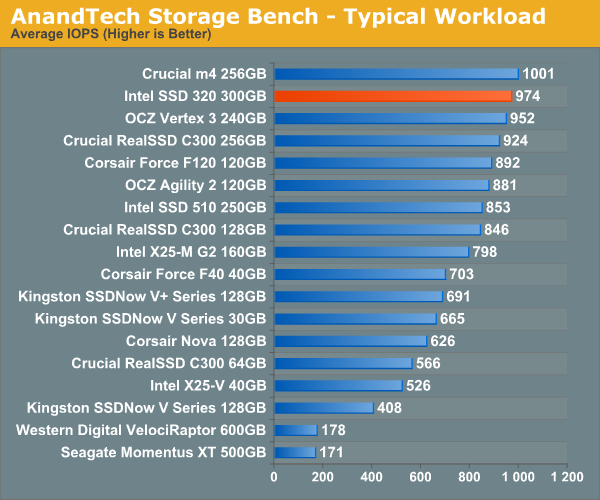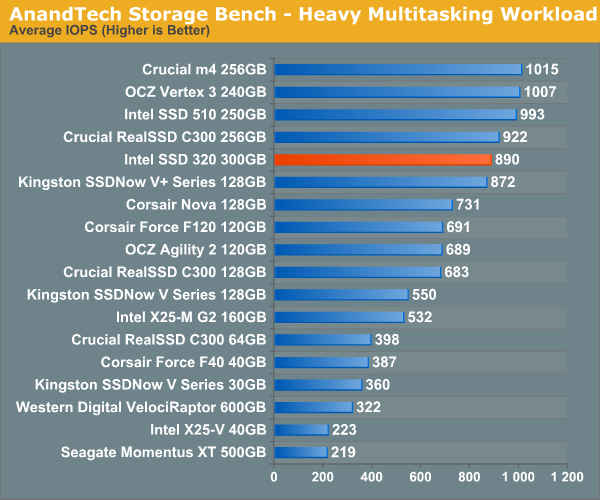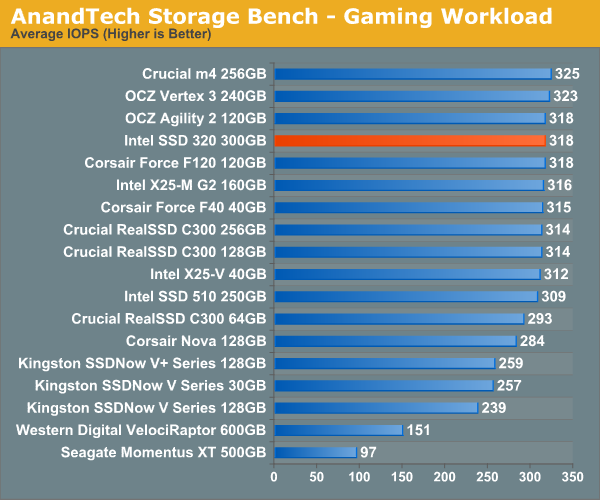The Intel SSD 320 Review: 25nm G3 is Finally Here
by Anand Lal Shimpi on March 28, 2011 11:08 AM EST- Posted in
- IT Computing
- Storage
- SSDs
- Intel
- Intel SSD 320
AnandTech Storage Bench 2010
To keep things consistent we've also included our older Storage Bench. Note that the old storage test system doesn't have a SATA 6Gbps controller, so we only have one result for the 6Gbps drives.
The first in our benchmark suite is a light/typical usage case. The Windows 7 system is loaded with Firefox, Office 2007 and Adobe Reader among other applications. With Firefox we browse web pages like Facebook, AnandTech, Digg and other sites. Outlook is also running and we use it to check emails, create and send a message with a PDF attachment. Adobe Reader is used to view some PDFs. Excel 2007 is used to create a spreadsheet, graphs and save the document. The same goes for Word 2007. We open and step through a presentation in PowerPoint 2007 received as an email attachment before saving it to the desktop. Finally we watch a bit of a Firefly episode in Windows Media Player 11.
There’s some level of multitasking going on here but it’s not unreasonable by any means. Generally the application tasks proceed linearly, with the exception of things like web browsing which may happen in between one of the other tasks.
The recording is played back on all of our drives here today. Remember that we’re isolating disk performance, all we’re doing is playing back every single disk access that happened in that ~5 minute period of usage. The light workload is composed of 37,501 reads and 20,268 writes. Over 30% of the IOs are 4KB, 11% are 16KB, 22% are 32KB and approximately 13% are 64KB in size. Less than 30% of the operations are absolutely sequential in nature. Average queue depth is 6.09 IOs.
The performance results are reported in average I/O Operations per Second (IOPS):

If we strip 6Gbps out of the equation completely, the SSD 320 does very well in our old light workload. You're looking at performance that's at the top of the pack from the mainstream offering.
If there’s a light usage case there’s bound to be a heavy one. In this test we have Microsoft Security Essentials running in the background with real time virus scanning enabled. We also perform a quick scan in the middle of the test. Firefox, Outlook, Excel, Word and Powerpoint are all used the same as they were in the light test. We add Photoshop CS4 to the mix, opening a bunch of 12MP images, editing them, then saving them as highly compressed JPGs for web publishing. Windows 7’s picture viewer is used to view a bunch of pictures on the hard drive. We use 7-zip to create and extract .7z archives. Downloading is also prominently featured in our heavy test; we download large files from the Internet during portions of the benchmark, as well as use uTorrent to grab a couple of torrents. Some of the applications in use are installed during the benchmark, Windows updates are also installed. Towards the end of the test we launch World of Warcraft, play for a few minutes, then delete the folder. This test also takes into account all of the disk accesses that happen while the OS is booting.
The benchmark is 22 minutes long and it consists of 128,895 read operations and 72,411 write operations. Roughly 44% of all IOs were sequential. Approximately 30% of all accesses were 4KB in size, 12% were 16KB in size, 14% were 32KB and 20% were 64KB. Average queue depth was 3.59.

Crank up the workload and the 320 falls a bit behind the rest of the competitors. Last year's heavy multitasking workload is nothing compared to what we introduced earlier this year, so it's still pretty light by comparison but it's clear for normal usage the 320's 3Gbps performance is quite good.
The gaming workload is made up of 75,206 read operations and only 4,592 write operations. Only 20% of the accesses are 4KB in size, nearly 40% are 64KB and 20% are 32KB. A whopping 69% of the IOs are sequential, meaning this is predominantly a sequential read benchmark. The average queue depth is 7.76 IOs.











194 Comments
View All Comments
sean.crees - Tuesday, March 29, 2011 - link
Have you thought that perhaps the new change was in your best interest? That maybe their trying to fix a problem before you notice it.Think about it, as a company, you would want to give your customers what they want. You'd give them all the space they'd want, i mean why not right? You'd want all the biggest numbers possible to slap on your box so you can brag to the entire market your the best. Then the only reason to make it less is to pre-emptively keep a potential problem from happening.
You have to remember, OCZ isn't Intel, they don't make these parts. They just put it together and repackage it. If their Nand suppliers suddenly have issues, they can't just stop selling products, they would go bankrupt, but a slight change in product specs that most people will never notice in real world usage to prevent future issues because of hardware supply problems?
I'm not saying this is what happened, but it is just one of many possible reasons why the change was made.
OCZ doesn't have intels Q&A because they can't afford it. What would you prefer, having only Intel SSD's because no one else can afford to be competative with them in this market and have the same Q&A and parts. Or some competition with some sacrifices? Most would agree this is the lesser of two evils.
But what OCZ lacks in funding they make up in customer support. You can go to their forums, make a post and within a reasonable amount of time get an actual tech from their company to respond to you with options to fix your problem. You don't get that personal touch from Intel. With Intel, if it's not in the box when you buy it, then you don't get it.
jwilliams4200 - Wednesday, March 30, 2011 - link
Lowering the performance of the product, and giving 5GB less space than advertised (or using lower tier flash memory) is NOT in the best interest of the customer. It was in OCZ's best interest to try to deceive their customers so OCZ could increase its profits, so that is what OCZ did.sean.crees - Wednesday, March 30, 2011 - link
And you have proof they intentionally used sub standard nand to increase profits? Or are you just making stuff up?jwilliams4200 - Wednesday, March 30, 2011 - link
OCZ has been using flash chips in some SSDs that have the Micron logo and then the SpecTek logo stamped on top. SpecTek sells flash chips that Micron will not sell. SpecTek is a lower tier.Making things up? Hardly. This has been discussed at length in a number of forums, and you can easily find credible pictures of the flash chips in OCZ SSDs from people who opened up the SSDs.
Ema Nymton - Tuesday, April 5, 2011 - link
Funny you say that,I just had the same discussion with a friend of mine.
Then I went with a OCZ deneva and opened it.
Guest what I found Intel Nan flash in it...
sean.crees - Tuesday, March 29, 2011 - link
Intel had the reliability vs speed in the 1st and 2nd gen SSD's, but the difference then was that the speed was competitive. It's not even close this time.Another thing i have against Intel, i was one of their early 1st gen adopters, 2x 80gb drives for $500 a pop. I'm the guy Intel screwed out of TRIM support because they didn't feel like sharing a firmware update that enables it for me. So i still have a bitter taste in my mouth over that, especially now that its been a few years and my 1st gen SSD's are starting to feel more like a fast HDD. :*(
Also, Sandforce and OCZ seem to have learned how important stability and performance sustainability are in this market. They have some of the best garbage collection without TRIM available. That's important especially for people considering OS's that don't support TRIM, or for RAID usage.
Intel may have created this market, but its competitors have learned the lessons Intel shared while Intel still needs to learn how to support its existing customer base like OCZ has gotten very good at. This is the problem with being #1 for too long, you begin to think you can do no wrong, and all your choices are the right ones that everyone else should conform to. This is fine as long as you keep your competitive edge, but once you lose that, you risk losing everything.
Intel may be able to brag about stability for now, but i have a feeling as time goes by people will realize that Sandforce drives are just as stable, and then Intel loses its only Ace left in it's hand.
jwilliams4200 - Tuesday, March 29, 2011 - link
You sound like an OCZ spin doctor.No, the Sandforce garbage collection is not one of the best. It is actually highly flawed. If you use the drive heavily, the write speed will drop, and it will stay low, even after TRIM, for up to a week. And Sandforce has done nothing to fix this. OCZ, in typical con-man fashion, claims it is a feature, but that is obviously a lie. If it were a feature, it would be documented under what circumstances it happens, how much the write speed decreases, and for how long. The write speed would drop more, too, since 30% drop in write speed is not going to do much to save the flash, even if the flash were really in danger, which it should not be. And if it were a feature, Sandforce would offer the ability to turn it off, if not by the user, at least by the vendor. No, it is a design flaw.
Even if OCZ users do not get deceived by OCZ in the future (by OCZ changing the internals to make the drive less reliable or perform worse), it is obvious that Intel will remain more reliable and stable than OCZ. There is just no comparison between the quality control and testing that happens at Intel, as an entire corporate culture, in contrast to OCZ, where the corporate culture is to take short-cuts, use the cheapest parts possible, lie to the customers whenever they feel like it, and then send the spin doctors out on the forums to attempt damage control. Ever since the OCZ spin doctors pretended to be users on hardforum years ago, it has been clear what sort of company OCZ is.
Acrono - Tuesday, March 29, 2011 - link
You sound like an Intel spin doctor.jwilliams4200 - Tuesday, March 29, 2011 - link
I have no association with Intel, other than appreciating their reliability. But of course there is no way for you to know that. The difference is that OCZ has a history of having their people post on forums, posing as non-OCZ "regular people". Intel has no such shady history.sean.crees - Tuesday, March 29, 2011 - link
I've actually never owned an OCZ product ever. But i keep up with how different companies in the IT domain behave. I read reviews, and keep up with trends."If you use the drive heavily", which the average consumer won't ever do. If you are going to be using this drive heavily then your making the mistake of buying a consumer product instead of a server product. You get what you pay for. Don't blame the company because your trying to use a product for a purpose it was never intended to be used for.
It is not the culture of Intel that gives them better quality control, its capital. Intel has a lot more resources available than OCZ. It can afford these premium parts, and better quality control.
Intel has good reliabilty, and if reliability is your #1 concern over all else, then your right, there is no other option. But most are willing to gamble that they will likely never see that increased reliability with intel, but will notice an increased speed with sandforce.